"Bayar" Erdenebayar
Monkhor (mong. "Баяр" Монхорын Эрдэнэбаяр)
Text in English
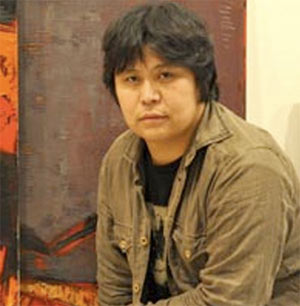
Erdenebayar Monkhor
Geboren 1968 in Baruun-Jurt, in der Mongolei.
Ausbildung
1983-1987 Die Hochschule der Bildende Künste in Ulaanbaatar, Mongolei.
1995-1996 Die Institut für Bildende Künste in Ulaanbaatar, Mongolei.
Solo Ausstellungen
2010 "Guardians of the Steppe" in Schoeni Art Gallery & Namfah Teo Gallery, Hongkong.
2009 "Journey of the Secret" in Ariyasomvilla, Bangkok, Thailand.
- "Travels of Red Horses" in Chinesische Haus, Phnom Penh, Kambodscha.
2008 "Red Horses in the Shadows" in Studio Napean Gallery, Mumbai, Indien.
2007 "Red Horses of Mongolia" in MICA Building, Singapur.
- "Red Horses of Mongolia" in TeoNamfah Gallery, Bangkok, Thailand.
1999 "Aziin Chono" Kunstgalerie von UMA (Union of Mongolian Artists), Ulaanbaatar, Mongolei.
1995 Einzelausstellung Kunstgalerie von UMA, Ulaanbaatar, Mongolei.
Zwei Personen Ausstellungen
2004 Indiana Memorial Gallery, Bloomington, Indiana, USA.
2003 Ausstellung - E & M, finanziert durch Gewährung von Arts Council of Mongolia, Kunstgalerie von UMA, Ulaanbaatar, Mongolei.
2001 Nomad Art Gallery, Ulaanbaatar, Mongolia Exhibition Center.
Gruppenausstellungen
2008 APBF Signature-Kunst-Preis, Singapur.
- Taiwan-Fusing Biennale.
- Beijing International Biennale
2005 Silk Road Contemporary Art Festival, Worth Ryder Gallery, Kunst-Fakultät der Universität Berkeley, Kalifornien, USA.
2004 "Mongolei & Tamna" Ausstellung von Kunst und Kultur, Jeju, Korea.
2003 "Mongolische Künstler" Cork Street Gallery, London, England
2002 "Aquarell" Biennale, Mexiko.
- "Asien Frühling" Fine Arts Association Busan, Korea.
- Art Gallery 4 NIH, Bethesda, Maryland.
2001 "Farben der Mongolei" Frankle Gallery, New York und Som Art Gallery, San Francisco, USA.
2000 "Schamane des Dschingis Khans" in Seoul, Korea.
- "Die Ausstellung der mongolischen Künstler" in Moskau, Russland.
- "00-87" Kunstgalerie von UMA, Ulaanbaatar, Mongolei.
1995 Inter Gallery, Seoul, Korea.
1992 "Ausstellung junger Künstler Mongolei" Ulaanbaatar, Mongolei.
Kunstmessen
2008 Santa Fe Art Fair.
2007 Singapore Art Fair.
Awards
1999 Preis von UMA (Union of Mongolian Artists).
Bibliographie
"A
Most Exotic Art Scene Blooms in Ulaanbaatar" (Ein ungewöhnliches
Kunstszene Blooms in Ulaanbaatar), von Daniel Schar, The New York
Times, 17. Juli 2005.
"The shows this month include diverse works by local artists, like Erdenebayar's cubist takes on the equine form."
Webseite: www.artbayarmugi.com
Text in
English
"Bayar" Erdenebayar Monkhor
Born in 1968 Baruun -Urt, Mongolia.
Education
1983-1987 Fine Arts College, Ulaanbaatar, Mongolia.
1995-1996 The Fine Art Institute, Ulaanbaatar, Mongolia.
Solo exhibitions
2010 "Guardians of the Steppe" Schoeni Art Gallery & Teo Namfah Gallery, Hong Kong.
2009 "Journey of the Secret" Ariyasomvilla, Bangkok, Thailand.
- "Travels of Red horses" Chinese House, Phnom Penh, Cambodia.
2008 "Red Horses in the Shadows" Studio Napean Gallery, Mumbai, India.
2007 "Red Horses of Mongolia" MICA Building, Singapore.
- "Red Horses of Mongolia" TeoNamfah Gallery, Bangkok, Thailand.
1999 "Aziin chono" Art Gallery of UMA (Union of Mongolian Artists), Ulaanbaatar, Mongolia.
1995 Solo exhibition Art Gallery of UMA, Ulaanbaatar, Mongolia .
Two person exhibitions
2004 Indiana Memorial Gallery, Bloomington, Indiana, USA.
2003 Exhibition - E&M, funded by Grant of Arts council of Mongolia, Art Gallery of UMA, Ulaanbaatar, Mongolia.
2001 Nomad Art Gallery, Ulaanbaatar, Mongolia Exhibition Center, Mongolia.
Group exhibitions
2008 APBF Signature Art Prize, Singapore.
- Taiwan-Fusing Biennale.
- Beijing International Biennale.
2005 Contemporary Silk Road Art Festival, Worth Ryder Gallery, Art Faculty, Berkeley University, California, USA.
2004 "Mongolia & Tamna" Exhibition of Culture and Art, Jeju, Korea.
2003 "Mongolian Artist" Cork Street Gallery, London, England.
2002 "Watercolor" Biennale, Mexico.
- "Asian Spring" Busan Fine Arts Association, Korea.
- NIH Art Gallery 4, Bethesda, Maryland.
2001 "Colors of Mongolia" Frankle Gallery, New York and Som Art Gallery, San Francisco, USA.
2000 "Shaman of the Chinggis Khan" Seoul, Korea.
- "The Exhibition of Mongolian Artists" Moscow, Russia.
- "00-87" Art Gallery of UMA, Ulaanbaatar, Mongolia.
1995 Inter Gallery, Seoul, Korea.
1992 "Mongolia Young Artists Exhibition" Ulaanbaatar, Mongolia.
Art fairs
2008 Santa Fe Art Fair.
2007 Singapore Art Fair.
Awards
1999 Prize from UMA (Union of Mongolian Artists).
Bibliography
"A Most Exotic Art Scene Blooms in Ulaanbaatar" , by Daniel Schar, The New York Times, July 17, 2005.
"The shows this month include diverse works by local artists, like Erdenebayar's cubist takes on the equine form."
Website: www.artbayarmugi.com
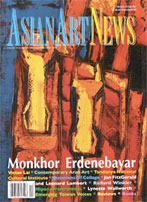 "Guardians Of The Steppe" By Ian Findlay-Brown
"Guardians Of The Steppe" By Ian Findlay-Brown
Copyright © Ian Findlay-Brown 2009
The
horse is central to the cultural and spiritual world of Mongolians and
one of their most important art motifs, even from the earliest rock
art. For Monkhor Erdenebayar the horse has long been the main subject
of his painting. And through this he not only expresses his love for
the animal but also uses it as a metaphor for Mongolian national
identity and as a way of exploring his own childhood memories.
By Ian Findlay
Myths
and legends that embrace the horse are myriad. Throughout time and
among innumerable folk cultures the horse—the stallion and the mare—has
been a potent metaphor for power and freedom, life and death, sacrifice
and darkness, magic and fertility, and for its ties to the heavens and
earth. While many cultures have long since lost their connection to the
horse, Mongolians still hold it close to their heart. One has only to
witness the essential place that the horse takes at traditional
Mongolian festivals across the vast steppe to see just how it speaks to
the nomadic soul and history of the nation. The young Mongolian painter
Monkhor Erdenebayar understands this very well indeed and uses this
knowledge in his recent work to address questions of personal and
national identity.
The new freedoms that came with Mongolia’s
democratic changes in the early 1990s opened the doors for new forms of
artistic expression. With the exception of a few older artists,
Soviet-style art and its constraints have now been relegated to history.
Mongolians
seized the opportunities afforded them by democratic change to
celebrate their culture with energy and openness: in art they embraced
new forms and styles, new subjects and themes. In 1993, however, while
his contemporaries turned to more modern subjects and Western-inspired
styles and forms, from impressionism to abstraction, Erdenebayar made a
conscious decision to adopt the horse as his central subject. For
Erdenebayar, or Bayar as he is known, his horses in the vastness of the
steppe or in the ruggedness of the mountains are the symbol of free
spirits that speak to Mongolian history, ancient traditions, and
culture in ways that cannot be achieved through painting scenes of
Mongolian life as it is lived in a city such as contemporary
Ulaanbaatar. Through the horse Erdenebayar is able to question his
history, to see it, sometimes in a somewhat sentimental light,
sometimes in an objective manner that is strikingly robust. There is,
too, in his horse painting a deep reservoir of personal memory on which
to draw, which resonates throughout his art.
“Family
tradition and abundant little antique wooden sculptures inspired me to
paint horses. My grandfather and my brothers used to draw very fancy
horses with pencil on paper. Their horses looked as fancy and as clean
as Arabian horses,” he says. “But my mother had a small piece of horse
hide and some paintings of Buddha, and small wooden horses, which she
kept in a chest. She kept these in the box to hide them from the
communis government.
“Sometimes, I feel that my childhood is
like those precious items that my mother kept hidden in the chest. I
had, and still have, a little collection of wooden horse sculptures. I
am interested in these wooden horses’ physical structures and
characters. It is these sculptures that connect my art to real life.”
(1)
One sees the notion of secrets hidden in boxes, a childhood
waiting to be explored and brought to life through art, in such works
as the bold, red-and-gold Secrets in My Box (2009) and dark, brooding
Secret Series No.1 (2009).
Monkhor Erdenebayar was born in 1968
in Baruun-Urt, Mongolia. He had a formal art education at the Fine Arts
College and Fine Art Institute, Ulaanbaatar, from which he graduated in
1987 and 1996 respectively. His art education embraced two very
different methodologies: the Soviet and a more Western-oriented
curricula. The former taught a rigid, propaganda- style art; the
latter, a freer, more personal expression.
The free-flowing
works that marked Erdenebayar’s early period included horses set within
rolling hills, the riders erect, in the style of Mongolian horsemen
that one sees across the steppe. The landscape has become
impressionistic, brief, or completely abstract through touches of
colors such as blue, red, green, or creamy white as in works such as In
the Summer Rain (2007), Blue Ocean, Red Steppe Series No.2, Guardian of
the Next Generation, Cool Day (all 2008), Autumn, Force of White, and
Snowbound (all 2009). There is an elegance and control to the rider and
the horses’ gait that speaks across all horse cultures; man is at one
with his horse and its spirit. As Erdenebayar’s painting has become
sparer in its geometry and the spirit that he projects has become more
contained within it; and even by his removal of any humans in his
paintings his art hasn’t lost its sense of drama. There is still a
feeling of dynamic spontaneity, and he achieves this, as he says, by
“fighting my paintings with my palette knife like a sword.” (2)
Erdenebayar
did not suddenly change from one style to another, one aesthetic
reality to the next. Rather he has achieved a formal quality and
directness beyond naturalism and realism, moving into an aesthetic that
has been obtained through careful research and experience. As
Erdenebayar says, “Formality is the soul of my work. I am very
interested in Western art and its formal and abstract qualities. I like
the simplest moves of my horses. And, although they may seem very
static, there is also a contemplative aspect in the simplicity. I am
trying to express the power of the horse and its confident character.
My point is to show that, even without a rider, there is a connection
between humankind and nature through the horse’s bowed head and its
body firmly rooted to the earth.”
Traditional views of horses
galloping across the steppe ridden by warriors on their way to battle
or hunting or raced by fierce nomads are clearly not for Erdenebayar.
Such scenes would be wholly out of place in his oeuvre. This is not to
say that he does not admire some of these scenes since they convey
something of Mongolia’s vision of itself, one that he is always keen to
interpret through his own formal, lyrical, and angular art without
making obvious history paintings or narratives. Indeed, besides his
attraction to some traditional anonymous tangka artists, he also likes
the works of Western artists such as the French painter Jean Dubuffet
(1901–1985) (“I like his crude style and textures”) and Mexican painter
Rufino Tamayo (1899–1991) (“I like how he could change ancient Mexican
culture into modern art”). But he is also attracted to art of the
Russian Nikolai Konstantinovich Rerikh (1874–1947). He points to
Rerikh’s The Red Hero with Red Horse (1927), which hangs in
Ulaanbaatar's Zanabazar Museum of Fine Arts, a large gouache-on-cotton
work that shows King Shambal riding his horse over the mountains of
Ulaanbaatar. Erdenebayar points out that this work, which is
tangkainspired, represents the future.
The formal qualities of
Erdenebayar’s paintings—line, color, lighting, and texture—are
striking. Although a prolific painter in recent years, the artist
clearly considers each line and color, and angle and posture,
carefully. He eschews preparatory sketches or drawings to articulate
his subject with an extraordinary energy as he paints directly onto the empty canvas,
which
typically takes a few days. With his “palette knife like a sword,” he
paints quickly. His guide is his knowledge and understanding of the
horse that began in childhood in the countryside. By painting directly
onto the canvas he feels that he is not so much creating something but
sensing rather “that my horses create themselves. Maybe it is because I
paint without sketching. I see not only the horses’ characters, but
also I feel myself. I feel my works in me and the excitement, patience,
speed, and power of the horses. The challenge for me is to make big
paintings that can represent these qualities of the horse.”
At
the same time, he notes that there is something serendipitous going on
over the time it takes to make a work. “I paint very fast so that I
feel that I am competing with every second of my time. When I am inside
my work, unexpected things happen and these help me. I can’t see the
ending of a work while I am painting. I feel that painting governs me.
Sometimes the ending is very different from what I had planned. So that
is why I do not use sketches. I love to use those unexpected moments to
make my art.”
The mood of Erdenebayar’s painting is a
precariously balanced one. His geometry, which reminds one of some of
Theo van Doesburg’s (1883–1931) drawings, lends his horses a solidity,
a physical presence and boldness of character that those by modern
artists of the American West or by the 18th-centruy English painter
George Stubbs (1724–1806) do not possess. The forms that make up his
horses in Red Steppe Series No.2 (2008), Red Moon Series No.2 (2008), and Ready to Go (2009) all have a
suggestion
of cubist geometry. Two of the clearest examples of this are Red Moon
Series No.2 and Ready to Go. The artist agrees with this while pointing
out “this painting is related to ancient rock carving. I think these
works, and many others, have the look of having been carved from rock
and are sculptural.”
Growing
up on the steppe accustomed Erdenebayar’s eye to rich natural colors in
the sunset and of the changing seasons as well as in the folk colors of
the traditional home known as ger (often referred to as yurt in the
West). He says that he often spent long periods looking at the
mountains, the changing colors of the trees, the turning of the
steppe’s grass as wind and rain and dryness took their toll, and all
the art that he could find. By understanding nature he has been able to
apply the rhythms and textures of it to painting by contrasting colors
and letting these light his work. This is no easy task. One can see
just how subtle his achievement is, which he says is a “game of
colors,” in works such as Secret Series No.1 Red Line in Black, Visitor
in Black (2009), in which three red horses and a black one crowd
together, and Stallion (2009), which is a single saddled horse – he
rarely uses saddles – looks out at the viewer as if it is waiting to be
mounted. But certainly one of Erdenebayar’s strongest works is Cool Day
in which two horses stand side by side, their features enhanced by the
artist’s use of white, red, and touches of blue and brown.
There
are some who may see Erdenebayar’s horse paintings and their colors as
repetitive, which in their minds diminishes Monkhor Erdenebayar, In the
Summer Rain, 2007, oil on canvas, 150 x 120 cm. their power. The artist
says that he sometimes wonders about this but he also There are some
who may see
Erdenebayar’s horse paintings and their colors as repetitive, which in
their minds diminishes Monkhor Erdenebayar, In the Summer Rain, 2007,
oil on canvas, 150 x 120 cm. their power. The artist says that he notes
that in repeating his subjects he finds new challenges. “It is not
repeating. I think this is an opportunity to challenge myself, which is
difficult but interesting,” he says. “Sometimes I am inspired by my old
works. I then do a new version, but through my view of art today. Some
people are fickle and easily bored: they can’t wait long enough to see
the process of my work, in
line and color, as well as philosophy.”
A
close look at his work, however, suggests qualities beyond light and
color. There is, for example, a lyrical quality about his forms, a hint
of a wild music to the geometry, and a timeless quality to be found in
such works as Snowbound (2009), in which two horses stare out at us
from the center of the canvas, their strong yellow faces, white and
creamy; Force of White (2009), where a pack of sturdy horses huddle
together as if to protect themselves, and the Guardian Of the Next
Generation, with its bold red and patches of green and orange. We ought
to look and wonder just how Erdenebayar pours his spirit onto his
canvases. Monkhor Erdenebayar’s horses do not prance, or gallop, or
canter. They are still, secretive creatures of strength, patience, and
independence. They see much and keep their secrets. Erdenebayar’s
secrets are now open. It is as if he is saying “look, Mongolians, we
are free.” But, at the same time, he is warning that while the boxes
open to freedom, encroaching city culture may well once more constrain
and trap people, crushing their hard-won freedoms before they are fully
realized.
Notes:
1.
All quotations from the artist, unless otherwise indicated, are taken
from interviews done in Mongolia, and at his exhibitions in Bangkok and
Phnom Penh in 2008 and 2009.
2. The author would like to thank Ms. Baysaa for her services as interpreter in Ulaanbaatar in October 2009.
Copyright © Ian Findlay-Brown 2009
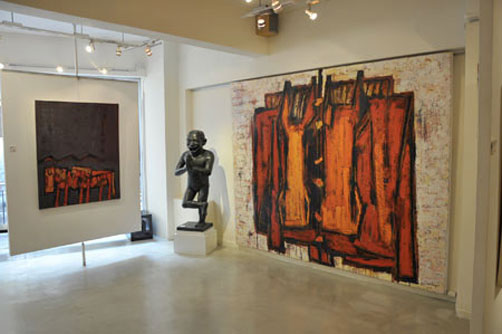 "Guardians of the Steppe" Schoeni Art Gallery Hong Kong 2010.
"Guardians of the Steppe" Schoeni Art Gallery Hong Kong 2010.
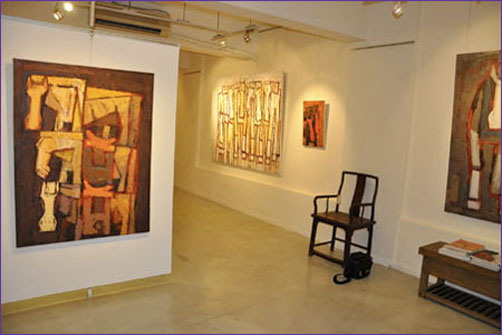 Guardians of the Steppe" Schoeni Art Gallery Hong Kong 2010.
Guardians of the Steppe" Schoeni Art Gallery Hong Kong 2010.
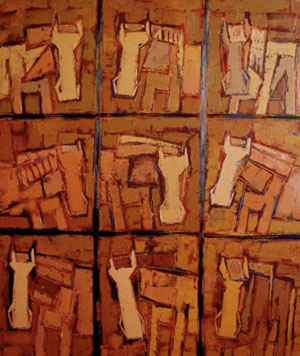
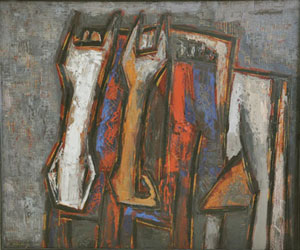
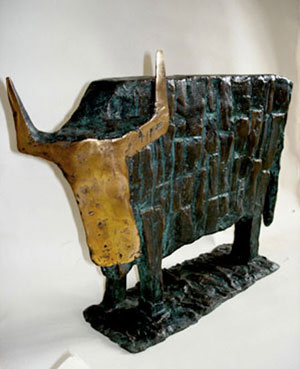
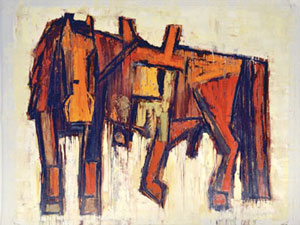

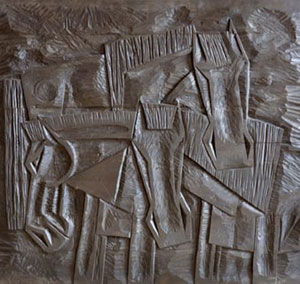
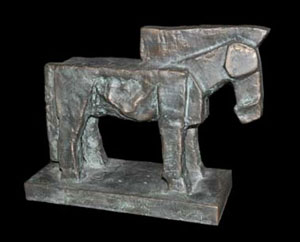
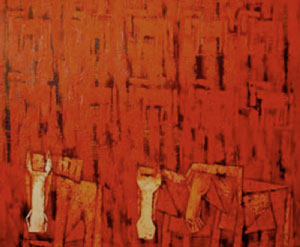
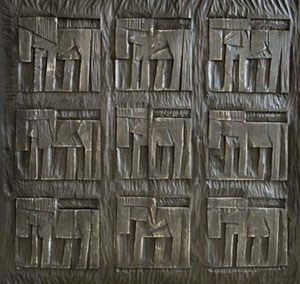
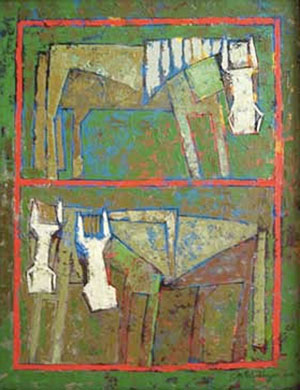
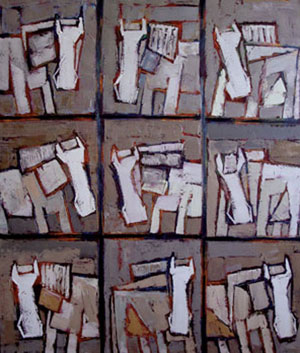
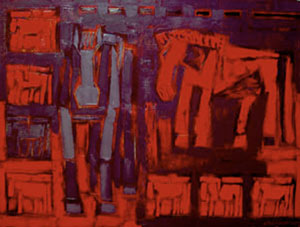

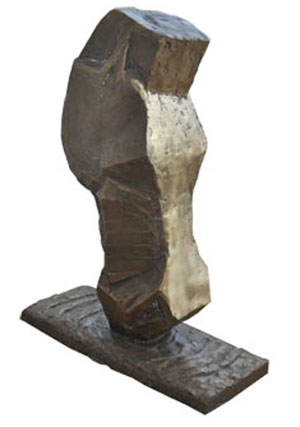


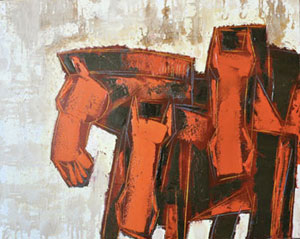
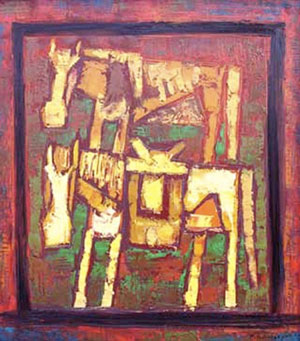
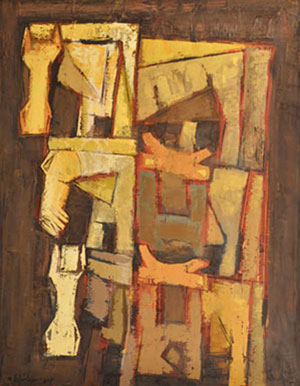
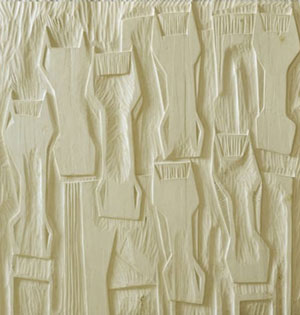
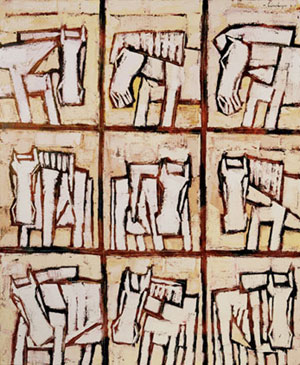



 "Guardians of the Steppe" Schoeni Art Gallery Hong Kong 2010.
"Guardians of the Steppe" Schoeni Art Gallery Hong Kong 2010. Guardians of the Steppe" Schoeni Art Gallery Hong Kong 2010.
Guardians of the Steppe" Schoeni Art Gallery Hong Kong 2010.